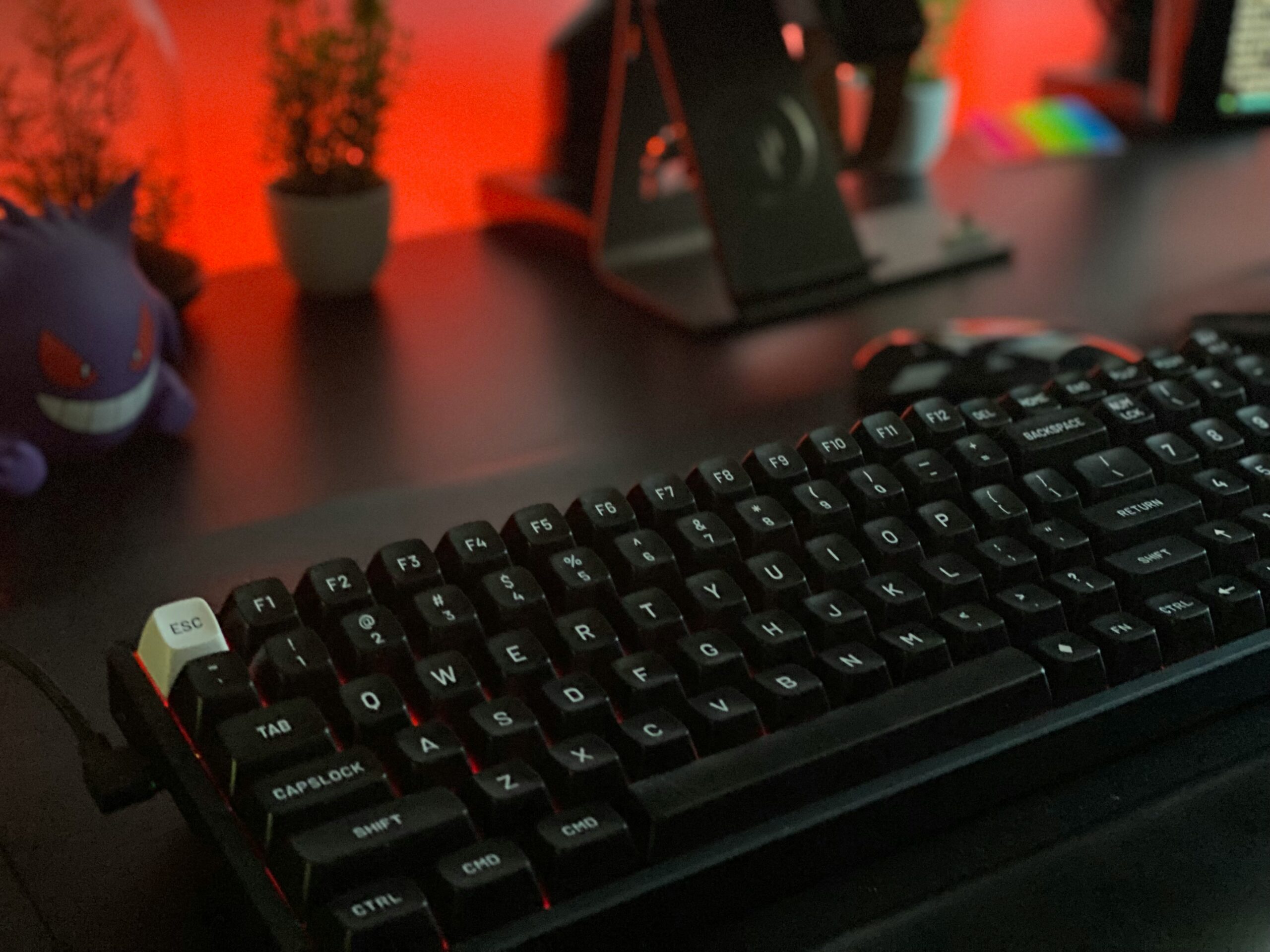Introduction to Assistive Keyboards
Assistive keyboards are specialized input devices designed to provide enhanced accessibility for individuals with disabilities. These keyboards aim to facilitate ease of communication and interaction with technology, removing barriers that may impede users’ ability to navigate and utilize their devices effectively. The importance of assistive keyboards lies in their capacity to empower disabled individuals, allowing them to participate fully in various activities, whether for work, education, or personal pursuits.
Individuals with a wide range of disabilities can benefit significantly from assistive keyboard technology. For instance, people with mobility impairments may find traditional keyboards challenging to use. In these cases, assistive keyboards designed with larger keys or different layouts can alleviate the physical strain involved in typing. Moreover, individuals with visual impairments may utilize keyboards that feature tactile elements or those equipped with audio feedback, providing an effective means to input data without relying solely on sight.
Alternative input methods are also an essential aspect of assistive keyboards for disabled users. For example, adaptive technologies such as on-screen keyboards and speech recognition software serve as integral components that enhance the functionality of standard keyboards. These options enable users to engage with their devices in diverse ways, addressing specific needs that arise from various disabilities. Additionally, certain assistive keyboards are designed to work seamlessly with these technologies, allowing for a personalized experience tailored to individual preferences.
As technology continues to evolve, the development of assistive keyboards will play a vital role in promoting inclusivity and enhancing the quality of life for disabled individuals. Recognizing the unique challenges these users face in today’s digital landscape is necessary for fostering an environment where everyone can participate fully and independently. In conclusion, understanding the significance of assistive keyboards and their various applications is crucial in advocating for accessibility and support for individuals with disabilities.
Types of Assistive Keyboards
Assistive keyboards for disabled individuals come in various forms, each designed to meet specific needs and enhance usability. Understanding the different types can assist users and caregivers in selecting the most appropriate device for effective communication and computer interaction.
One of the most common types is the ergonomic keyboard, which is designed to reduce strain and improve comfort during use. These keyboards typically feature a split layout and a cushioned wrist rest. By promoting a more natural hand position, ergonomic keyboards mitigate the risk of repetitive strain injuries, making them ideal for users who may have physical limitations or chronic pain.
Adaptive keyboards are tailored to accommodate various disabilities by modifying the standard keyboard layout. These keyboards may include larger keys, high-contrast colors, or tactile features to assist users with visual or motor impairments. Such adaptations allow users to type more comfortably and efficiently, enhancing their productivity and overall experience.
Switch-accessible devices offer an alternative input method for individuals with severe mobility limitations. These keyboards use external switches that can be activated through a variety of motions, such as pressing, blowing, or even eye movement. This flexibility allows users to interact with their computers without the need for traditional keyboard functions, thus opening up a wide range of accessibility options.
On-screen keyboards are software-based solutions that display a virtual keyboard on the computer screen. Users can input characters by tapping on the screen or using alternative inputs like a mouse or adaptive devices. This method is particularly beneficial for individuals who may have difficulty using physical keyboards, providing a customizable approach to typing and navigation.
Each type of assistive keyboard offers unique features designed to cater to specific user needs. By exploring these options, individuals can find the most suitable assistive keyboard to support their communication and computer usage effectively.
Benefits of Using Assistive Keyboards
Assistive keyboards for disabled individuals are specifically designed to address the unique needs of users with mobility or dexterity challenges. One prominent benefit of these specialized devices is the increased comfort they provide. Traditional keyboards often necessitate repetitive motions that can lead to discomfort or strain, particularly for users with limited fine motor skills. In contrast, assistive keyboards offer customizable layouts and ergonomic designs, ensuring that positions and controls can be tailored to individual needs, thereby enhancing comfort during extended use.
Improved typing speed is another significant advantage offered by assistive keyboards. Many of these keyboards come with larger keys or even customizable key functions, allowing users to type more efficiently without the frustration that may arise from conventional keyboards. This feature is particularly beneficial for those who may struggle with accuracy due to physical limitations. By facilitating a more fluid typing experience, assistive keyboards can lead to substantial gains in productivity.
Moreover, precision and accuracy are crucial aspects for users with disabilities. Assistive keyboards often include features like tactile feedback and key definitions that cater specifically to the requirements of users, thus reducing the chances of errors. This not only aids in effective communication but also contributes to a greater sense of independence, enabling users to navigate digital environments more confidently.
Finally, the use of assistive keyboards fosters a feeling of empowerment. By improving typing speed and accuracy while minimizing physical strain, these keyboards help users complete tasks independently, boost their overall productivity, and enhance their quality of life. In essence, assistive keyboards play a vital role in promoting accessibility, making technology more inclusive for individuals with disabilities.
Choosing the Right Assistive Keyboard
Selecting the most suitable assistive keyboard for individuals with disabilities is crucial for promoting effective communication and enhancing overall quality of life. When considering options, several factors must be taken into account to ensure the selected keyboard appropriately meets the user’s specific needs. A primary consideration is the type of disability, as varying disabilities may require distinct features. For example, individuals with limited mobility may benefit from larger keys or ergonomic designs, while those with visual impairments might need keyboards with high-contrast colors or tactile feedback.
The age of the user is another significant factor. Children might prefer colorful, engaging designs, while adults may favor a more professional appearance. Additionally, familiarity with existing technology should be evaluated. Users accustomed to specific devices may find it easier to transition to an assistive keyboard that closely resembles regular keyboards, minimizing the learning curve and facilitating an easier adaptation process. On the other hand, users unaccustomed to technology might benefit from keyboards featuring simplified layouts or intuitive interfaces.
When evaluating different models, consider trying out various options in person if possible. Many suppliers offer trial periods that allow users to test assistive keyboards before committing to a purchase. This hands-on experience can be invaluable as it provides insight into the comfort and usability of the keyboard in day-to-day scenarios. Furthermore, gathering feedback from current users can offer invaluable perspectives, shedding light on the strengths and weaknesses of particular models.
Finally, it is essential to consider the level of customization available in assistive keyboards for disabled individuals. Options that allow personalization can enhance usability, ensuring a more tailored experience. By taking into account these factors, individuals can make an informed decision regarding the assistive keyboard that will best support their needs.
Top Assistive Keyboard Brands and Models
When considering assistive keyboards for disabled individuals, several brands stand out for their commitment to quality, functionality, and user-centric design. Among these, Logitech and Microsoft are well-known for offering a range of assistive keyboard options that cater to varying needs.
Logitech’s K400 Plus Wireless Touch Keyboard is a prime example of versatility. Featuring a built-in touchpad, it allows users to navigate their devices seamlessly without the need for an external mouse. This assistive keyboard is particularly beneficial for individuals with limited mobility, providing a convenient solution for using computers and smart TVs. Priced affordably, it has garnered positive user reviews for its simplicity and reliability.
Another noteworthy option is Microsoft’s Surface Ergonomic Keyboard, designed to promote better posture and comfort during use. Its split design is ideal for individuals suffering from repetitive strain injuries or those who find traditional keyboards uncomfortable. The keyboard also includes customizable keys, allowing users to tailor functions according to their preferences. Microsoft’s brand is generally well-regarded, and this model has received acclaim for its build quality and ergonomic design.
For those seeking more specialized solutions, companies such as Tresamme and Keyman are noteworthy. Tresamme offers the FlipSwitch keyboard, which features oversized keys and a unique design to assist users with severe motor impairments. This specific type of assistive keyboard is designed to enhance accessibility and facilitate easier typing for those with significant challenges. Similarly, Keyman’s Adaptive Keyboard is renowned for its customizable layouts and tactile feedback, making it a popular choice among users requiring enhanced interaction methods.
Ultimately, the wide array of assistive keyboards for disabled users available on the market reflects the diversity of individual needs. Selecting the right brand and model is essential for maximizing user experience and ensuring effective communication and interaction with technology.
Setting Up and Customizing Assistive Keyboards
When it comes to assistive keyboards for disabled individuals, the setup process is crucial for ensuring that users gain optimal benefits from these devices. The initial step typically involves connecting the keyboard to the user’s computer or tablet. This connection can be achieved via wired or wireless methods. Wired assistive keyboards are simply plugged into a USB port, providing a stable connection. In contrast, wireless keyboards require Bluetooth or a USB receiver, offering greater flexibility and mobility for users.
Once connected, users may encounter a general user interface that is familiar yet tailored for accessibility purposes. Operating systems often recognize assistive keyboards automatically, allowing users to engage with built-in features designed to enhance navigation. For instance, many systems will provide prompts to modify keyboard settings immediately upon detection of an assistive device.
Customizing settings is key to maximizing the usability of assistive keyboards. Many keyboards come equipped with options to adjust key sensitivity, allowing users to tailor responses based on their unique capabilities. This feature is particularly beneficial for individuals with limited dexterity, ensuring that keystrokes are registered with minimal effort.
Additionally, users can often change the layout of keys according to personal preference or accessibility needs. Some may opt for larger key sizes or specific color-coding to aid visibility. The ability to create and assign macro functions enables users to execute complex commands with a single keystroke, significantly improving efficiency and ease of use. This can be a vital feature for individuals who frequently execute repetitive tasks or require shortcuts to streamline their workflow.
Overall, the setup and customization of assistive keyboards for disabled individuals play a significant role in enhancing accessibility and user experience, contributing to a more inclusive technological environment.
Real-Life Applications and Success Stories
Assistive keyboards for disabled individuals have made significant strides in enhancing the quality of life for many users. One such story is that of Emily, a young woman with cerebral palsy, who struggled with traditional keyboard layouts. After being introduced to an assistive keyboard tailored to her specific needs, Emily reported a remarkable improvement in her ability to communicate effectively. The device allowed her to participate in online courses, enabling her to pursue a degree in graphic design, which had always been her dream.
Another inspiring case is that of Michael, a software engineer with limited mobility in his arms. Michael switched to an adaptive keyboard that features large keys and customizable layouts. This transformation not only increased his typing speed but also enhanced his productivity at work. By utilizing assistive keyboards for disabled users, he has successfully authored several technical papers and contributed to major projects, showcasing how tailored solutions can empower individuals in professional settings.
The educational field also benefits from these advancements. Sarah, a high school student diagnosed with dyslexia, faced challenges with traditional typing methods. However, her school provided her with an assistive keyboard designed for accessibility, complete with predictive text features and voice input options. This enhancement not only alleviated her frustrations with typing assignments but also encouraged her to engage more actively in classroom discussions. The device played a pivotal role in improving her academic performance and boosting her confidence.
These examples demonstrate that assistive keyboards for disabled individuals do not just serve a functional purpose; they empower users to thrive in various aspects of life, including education and professional environments. The stories of Emily, Michael, and Sarah illustrate the profound effects of accessible technology, highlighting the potential for independence and success that comes with the right tools.
Challenges and Limitations of Assistive Keyboards
While assistive keyboards for disabled users serve as invaluable tools to enhance accessibility, they are not without their challenges and limitations. One significant hurdle many users encounter is the steep learning curve associated with these devices. Users may find it daunting to adapt to a new keyboard layout or specialized features designed for their unique needs. This adjustment period can lead to frustration, particularly for those who may not be technologically inclined or who have used traditional keyboards for an extended period.
Additionally, technology compatibility poses another challenge. Not all assistive keyboards seamlessly integrate with every operating system or software application. This discrepancy may lead to limited functionality or the need for additional software updates or adjustments. For instance, a user of an assistive keyboard for disabled individuals may realize that certain key features do not work with legacy systems or specific programs, thereby hindering their overall productivity.
Moreover, ongoing support is crucial for users of assistive keyboards. As technology evolves, users often require guidance or troubleshooting to effectively utilize their devices. Accessibility training programs or support groups can mitigate these challenges; however, they may not always be readily available or accessible to all users. This lack of support can exacerbate the difficulties faced by those trying to navigate their assistive technology.
To overcome these hurdles, manufacturers of assistive keyboards for disabled individuals are encouraged to prioritize user-friendly designs and ensure compatibility with a wide range of operating systems. Additionally, providing robust support resources, including tutorials and community forums, can empower users to become comfortable with their devices. By addressing these challenges proactively, both users and manufacturers can contribute to a more inclusive and accessible technological environment.
Future of Assistive Keyboard Technology
The future of assistive keyboard technology is poised for significant advancement, driven by innovations in design, integration, and artificial intelligence (AI). As society becomes increasingly aware of the needs of individuals with disabilities, the demand for more intuitive and adaptive assistive keyboards continues to rise. One of the key trends shaping the future is the evolution of ergonomic designs that prioritize user comfort and accessibility. Manufacturers are focusing on creating keyboards that cater to various disabilities, offering customizable layouts, key sizes, and tactile feedback to enhance user experience.
Integration with smart home technology is another promising development in the realm of assistive keyboards for disabled individuals. Future devices are expected to seamlessly connect with smart home systems, enabling users to control their environment effortlessly. Imagine a scenario where a user can operate lights, thermostats, and even security systems through their assistive keyboard, providing an unprecedented level of independence and freedom. This interconnectedness highlights the potential for assistive keyboards to serve not only as communication tools but also as central hubs in smart home ecosystems.
Moreover, the incorporation of AI is set to revolutionize assistive keyboard technology. Future keyboards will likely feature machine learning capabilities, allowing the devices to adapt to users’ preferences and habits over time. This personalizing of features will enhance efficiency and streamline tasks, making typing and navigation easier for those with disabilities. For instance, predictive text and voice recognition may be integrated into these keyboards, providing users with advanced options for communication and control.
In conclusion, the future of assistive keyboards for the disabled is bright, thanks to advances in ergonomic design, smart technology integration, and AI. These innovations are designed to empower individuals with disabilities, fostering greater independence and accessibility in their daily lives.



